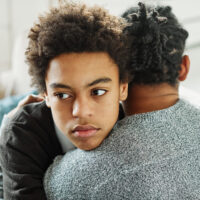National Institute for Health and Care Excellence (NICE)
Social anxiety disorder: recognition, assessment and treatment. https://www.nice.org.uk/guidance/cg159/chapter/1-Recommendations#identification-and-assessment-of-children-and-young-people
Sources
Public Health England (PHE). (2016) The mental health of children and young people in England. London Public Health England. Available at: https://www.gov.uk/government/publications/improving-the-mental-health-of-children-and-young-people [Accessed 10 July 2017]
Creswell C, Waite P, Cooper PJ. (2014) Assessment and management of anxiety disorders in children and adolescents Archives of Disease in Childhood; 99:674-678. Available at: http://adc.bmj.com/content/99/7/674 [Accessed 10 July 2017]
Van Steensel, F. J. A., Bögels, S. M., & Perrin, S. (2011). Anxiety Disorders in Children and Adolescents with Autistic Spectrum Disorders: A Meta-Analysis. Clinical Child and Family Psychology Review, 14(3), 302–317. http://doi.org/10.1007/s10567-011-0097-0 Available at: https://www.ncbi.nlm.nih.gov/pmc/articles/PMC3162631/ [Accessed 10 July 2017]
Khan L. (2015) Missed Opportunities: A review of recent evidence into children and young people’s mental health. London. Centre for Mental Health. Available at: http://www.centreformentalhealth.org.uk/Handlers/Download.ashx?IDMF=37cccf4c-c86b-4e64-ba8c-e7774cac66c7 [Accessed 10 July 2017]
American Psychiatric Association (APA) (2013) Diagnostic and Statistical Manual of Mental Disorders (DSM-V). APA Press, Arlington, VA. Available at: http://dsm.psychiatryonline.org/doi/book/10.1176/appi.books.9780890425596 [accessed 8 June 2017]
Costello EJ, Egger HL, Angold A. Developmental epidemiology of anxiety disorders. In: Ollendick TH, March JS editor(s). Phobic and Anxiety Disorders in Children and Adolescents: A Clinician’s Guide to Effective Psychosocial and Pharmacological Interventions. New York: Oxford University Press, 2004:61-91.
James AC, James G, Cowdrey FA, Soler A, Choke A. Cognitive behavioural therapy for anxiety disorders in children and adolescents. Cochrane Database of Systematic Reviews 2015, Issue 2. Art. No.: CD004690. DOI: 10.1002/14651858.CD004690.pub4. Available at: http://onlinelibrary.wiley.com/doi/10.1002/14651858.CD004690.pub4/full [Accessed 10 July 2017]
Mental elf link: https://www.nationalelfservice.net/mental-health/anxiety/cochrane-review-finds-solid-evidence-for-cbt-for-anxiety-in-young-people-but-lacks-evidence-for-long-term-benefits
Evans, D.L., Foa, E.B., Gur, R.E. et al (2012) Treating and preventing adolescent mental health disorders: What We Know and What We Don’t Know. A Research Agenda for Improving the Mental Health of Our Youth. Oxford. Oxford University Press. Available at: http://oxfordmedicine.com/view/10.1093/9780195173642.001.0001/med-9780195173642-chapter-10?rskey=DRkzHY&result=1 [Accessed 14 July 2017]
Cornacchio, D., Chou, T., Sacks, H., et al. (2015). Clinical consequences of the revised DSM-5 definition of agoraphobia in treatment-seeking anxious youth. Depression and Anxiety, 32(7), 502–508. http://doi.org/10.1002/da.22361 Available at: https://www.ncbi.nlm.nih.gov/pmc/articles/PMC5340313/ [Accessed 14 July 2017]
Green, H., McGinnity, A.,Meltzer, H. et al. (2005) Mental health of children and young people in Great Britain, 2004. Office for National Statistics. Newport. HMSO. Available at: http://content.digital.nhs.uk/catalogue/PUB06116/ment-heal-chil-youn-peop-gb-2004-rep2.pdf [Accessed 14 July 2017]
Michelini, G., Eley, T. C., Gregory, A. M. and McAdams, T. A. (2015), Aetiological overlap between anxiety and attention deficit hyperactivity symptom dimensions in adolescence. J Child Psychol Psychiatr, 56: 423–431. doi:10.1111/jcpp.12318 Available at: http://onlinelibrary.wiley.com/doi/10.1111/jcpp.12318/full [Accessed 14 July 2017]
Yap, M.B.H., Pilkington, P.D., Ryan, S. M., & Jorm, A.F. (2013). Parental factors associated with depression and anxiety in young people: A systematic review and meta-analysis. Journal of Affective Disorders. Available at: http://reseauconceptuel.umontreal.ca/rid=1NJ3Z7NPQ-VXMFJP-179V0/GERVAIS_Alexandra_Vignette7_Article.pdf [Accessed 14 July 2017]
Mental elf link: https://www.nationalelfservice.net/mental-health/anxiety/systematic-review-identifies-key-parenting-factors-associated-with-adolescent-depression-and-anxiety/
National Institute for Health and Care Excellence (NICE) (2013) Social anxiety disorder: recognition, assessment and treatment. Available at: https://www.nice.org.uk/guidance/cg159/chapter/1-Recommendations#identification-and-assessment-of-children-and-young-people [Accessed 14 July 2017]
Merikangas, K. R., He, J., Burstein, M. E., Swendsen, J. et al. (2011). Service Utilization for Lifetime Mental Disorders in U.S. Adolescents: Results of the National Comorbidity Survey Adolescent Supplement (NCS-A). Journal of the American Academy of Child and Adolescent Psychiatry, 50(1), 32–45. http://doi.org/10.1016/j.jaac.2010.10.006 Available at: https://www.ncbi.nlm.nih.gov/pmc/articles/PMC4408275/ [Accessed 14 July 2017]
Schimmenti, A. and Bifulco, A. (2015), Linking lack of care in childhood to anxiety disorders in emerging adulthood: the role of attachment styles. Child Adolesc Ment Health, 20: 41–48. doi:10.1111/camh.12051 Available at: http://onlinelibrary.wiley.com/doi/10.1111/camh.12051/full [Accessed 17 July 2017]
Weare K (2012) Evidence for the Impact of Mindfulness on Children and Young People. Mindfulness in schools project. University of Exeter. https://mindfulnessinschools.org/wp-content/uploads/2013/02/MiSP-Research-Summary-2012.pdf [accessed 17 July 2017]
Crowley, M. J., Nicholls, S. S., McCarthy, D et al. (2017), Innovations in practice: group mindfulness for adolescent anxiety – results of an open trial. Child Adolesc Ment Health. doi:10.1111/camh.12214 Available at: http://onlinelibrary.wiley.com/doi/10.1111/camh.12214/full [accessed 17 July 2017]
Bar-Haim, Y. (2010) Research Review: attention bias modification (ABM): a novel treatment for anxiety disorders. Journal of Child Psychology and Psychiatry, 51: 859–870. doi: 10.1111/j.1469-7610.2010.02251.x Available at: http://onlinelibrary.wiley.com/wol1/doi/10.1111/j.1469-7610.2010.02251.x/full [accessed 17 July 2017]
Lowther H, Newman E. (2014) Attention bias modification (ABM) as a treatment for child and adolescent anxiety: a systematic review. J Affect Disord. Oct;168:125-35. doi: 10.1016/j.jad.2014.06.051. Epub 2014 Jul 5. Available at: http://www.jad-journal.com/article/S0165-0327(14)00419-4/fulltext, [accessed 17 July 2017]
March S, Spence SH, Donovan CL. (2009) The efficacy of an internet-based cognitive-behavioral therapy intervention for child anxiety disorders. J Pediatr Psychol; 34:474–87. Available at: https://academic.oup.com/jpepsy/article-pdf/34/5/474/6313867/jsn099.pdf [accessed 17 July 2017]
Khanna M, Kendall P. (2010) Computer-assisted cognitive behavioral therapy for child anxiety: Results of a randomized clinical trial. J Consult Clin Psychol; 78:737–45. Available at: https://pdfs.semanticscholar.org/f547/b2ed93fd4962c11aa79b0ab932590ad3f772.pdf [accessed 17 July 2017]
Stallard, P. (2013) School-based interventions for depression and anxiety in children and adolescents. Evidence-Based Mental Health, 16 (3). pp. 60-61. ISSN 1362-0347 Available at: http://opus.bath.ac.uk/35734/1/Stallard_EBMH_2013.pdf [accessed 25 June 2017]
Teubert,D., & Pinquart,M. (2011). A meta-analytic review on the prevention of symptoms of anxiety in children and adolescents. Journal of Anxiety Disorders, 25(8), 1046-1059. Available at: https://www.ncbi.nlm.nih.gov/pubmedhealth/PMH0052967/ [accessed 17 July 2017]
Ipser JC, Stein DJ, Hawkridge S, Hoppe L. Pharmacotherapy for anxiety disorders in children and adolescents. Cochrane Database of Systematic Reviews 2009, Issue 3. Art. No.: CD005170. DOI: 10.1002/14651858.CD005170.pub2. Available at: http://onlinelibrary.wiley.com/doi/10.1002/14651858.CD005170.pub2/abstract [accessed 17 July 2017]
Kerns C.M., Read K.L., Klugman, J. et al. (2013) Cognitive behavioral therapy for youth with social anxiety: Differential short and long-term treatment outcomes. Journal of Anxiety Disorders. 27(2): 210-215. https://doi.org/10.1016/j.janxdis.2013.01.009 Available at: http://www.sciencedirect.com/science/article/pii/S0887618513000212 [accessed 17 July 2017]
Brown A. (2014) Predictors of change in treatment outcome for parent-delivered guided CBT bibliotherapy for children with anxiety: Effects of age, severity and comorbidity at long term follow-up. Doctoral thesis, UCL (University College London). Available at: http://discovery.ucl.ac.uk/1449265/ [accessed 5 Oct 2017]
Thirlwall,K., Cooper, P.J., Karalus, J. et al. (2013) Treatment of child anxiety disorders via guided parent-delivered cognitive-behavioural therapy: randomised controlled trial. The British Journal of Psychiatry 203 (6) 436-444; DOI: 10.1192/bjp.bp.113.126698 Available at: http://bjp.rcpsych.org/content/203/6/436?ijkey=0e8813e2cce88e26dbad57e40934091ed5f5d868&keytype2=tf_ipsecsha [accessed 17 July 2017]
Hudson, J. L., Lester, K. J., Lewis, C. M., et al. (2013), Predicting outcomes following cognitive behaviour therapy in child anxiety disorders: the influence of genetic, demographic and clinical information. J Child Psychol Psychiatr, 54: 1086–1094. doi:10.1111/jcpp.12092 Available at: http://onlinelibrary.wiley.com/doi/10.1111/jcpp.12092/full [accessed 17 July 2017]
Bouchard S, Dumoulin S, Robillard G, et al. (2016) Virtual reality compared with in vivo exposure in the treatment of social anxiety disorder: a three-arm randomised controlled trial. The British Journal of Psychiatry, bjp.bp.116.184234; DOI: 10.1192/bjp.bp.116.184234 Available at: http://bjp.rcpsych.org/content/early/2016/12/01/bjp.bp.116.184234 [accessed 17 July 2017]
Mental elf link: https://www.nationalelfservice.net/mental-health/anxiety/virtual-reality-for-social-anxiety-disorder/





